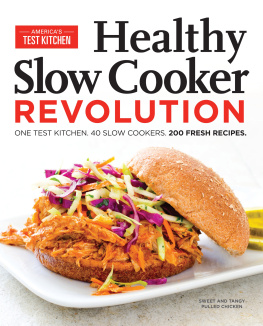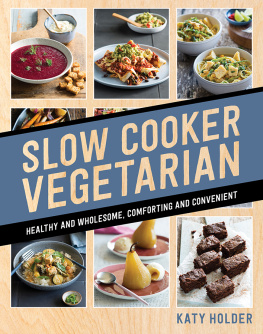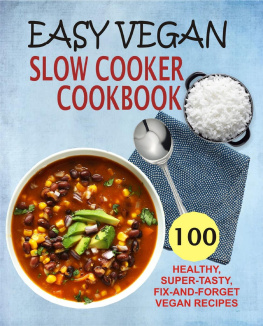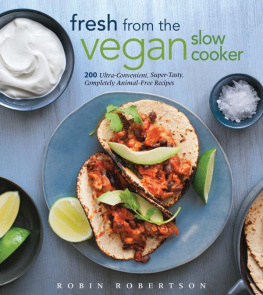The Harvard Common Press
535 Albany Street
Boston, Massachusetts 02118
www.harvardcommonpress.com
Copyright 2012 by Robin Robertson
Cover photographs copyright 2012 by Sabra Krock
All rights reserved. No part of this publication may be reproduced or transmitted in any form or by any means, electronic or mechanical, including photocopying, recording, or any information storage or retrieval system, without permission in writing from the publisher.
Printed in the United States of America
Printed on acid-free paper
Library of Congress Cataloging-in-Publication Data
Robertson, Robin (Robin G.)
Fresh from the vegan slow cooker : 200 ultra-convenient, super-tasty, completely animal-free recipes /
Robin Robertson. 1st ed.
p. cm.
Includes index.
ISBN 978-1-55832-790-0 (alk. paper)
1. Vegan cooking. 2. Vegetarian cooking. 3. Electric cooking, Slow. 4. One-dish meals. 5. Cookbooks.
I. Title.
TX837.R624928 2012
641.5'636dc23
2012004605
Special bulk-order discounts are available on this and other Harvard Common Press books. Companies and organizations may purchase books for premiums or resale, or may arrange a custom edition, by contacting the Marketing Director at the address above.
Cover recipe: Seitan Ropa Vieja,
Back cover recipes: Sunday Supper Strata,
Cover design by Night & Day Design
Text design by Jill Weber
Cover photography and prop styling by Sabra Krock; food styling by Carrie Purcell
10 9 8 7 6 5 4 3 2 1
Dedicated to compassionate people everywhere
who love animals and don't eat them
Acknowledgments
Many thanks to the wonderful recipe testers who slow-cooked their way through all of the recipes in this book, giving me invaluable feedback along the way: Amanda Sacco, Andrea Zeichner, Barbara Bryan, Dave Melmer, Debbie Cowherd, Heather Galaxy, Jill Paschal, Joan Farkas, Jocelyn Kimmel, Jonathan and Nancy Shanes, Julie Smallwood, Lea Jacobson, Lori Maffei, Lyndsay Orwig, Melissa Chapman, Melissa West, Sabrina Butkera, Terri Merritts, and Vegan Aide. Your careful and enthusiastic testing made my job much easier.
Special appreciation goes to my husband, Jon Robertson, for always being there for me.
I'm also grateful to Bruce Shaw and everyone at The Harvard Common Press for their part in making this book a reality, with special thanks to editor Valerie Cimino and copyeditor Karen Wise for being so great to work with. Thanks also to my longtime agent, Stacey Glick of Dystel & Goderich Literary Management.
Introduction
The irresistible appeal of a slow cooker is its convenience and simplicity. Turn it on, and it cooks dinner while you do other things. You have no pot to watch. It doesn't burn or spill over. Just set it and let it do its work. Next thing you know, your kitchen smells heavenly, and you feel like your personal chef did all the work.
Slow cookers first appeared in the 1970s, and you could get one in harvest gold, avocado green, or maybe decorated with orange flowers. Back then, the Crock-Pot (as the Rival Company, which is now a brand of Sunbeam Products, trademarked it) was mostly favored for cooking tough cuts of meat. The Crock-Pot left the limelight for a while, but in 2002, when I wrote my first slow cooker cookbook (Fresh from the Vegetarian Slow Cooker, The Harvard Common Press, 2004), slow cookers were enjoying a comeback. The goal of my first slow cooker book was to show how versatile slow cookers are for vegetarian cookingthey can be used to prepare everything from breakfast to dessert.
Fast forward 10 years from writing that first book, and the popularity of slow cookers shows no sign of waning. In addition, more people are enjoying a plant-based diet than ever before. Since that first slow cooker cookbook was published, I've written many other titles, but I never stopped developing new recipes, discovering new techniques, and exploring new ideas for vegan slow cooking. As I've explored new ways to use the slow cooker for plant-based meals, I've been continually amazed at the effectiveness of slow cookers for vegan recipes. Over the years, I have developed scores of new recipes and explored the world's cuisines to discover more creative ways to prepare food using the slow cooker method. What I came up with was enough to fill another book.
I'm pleased and proud, therefore, to present this new book to you. It contains more than 200 recipes using only plant-based ingredients. While I've included much of the general information and some of the basic recipes from the first book, this new volume contains mostly new recipes and lots of new tips and pointers for making the most of your slow cooker experience. I've worked hard to make the recipes accessible using most sizes of slow cookers. In addition to being 100 percent plant-based, many of the recipes are also gluten-free, soy-free, or low in fat.
We all know that a slow cooker is ideal for cooking beans, soups, and stews, but as you explore the pages of Fresh from the Vegan Slow Cooker, you'll discover a whole new slow-cooking world. The slow cooker can be used to make braised vegetable dishes, comforting casseroles, luxurious risottos, and fun dips and snacks. It can even be used to "bake" potatoes, breads, pts, and desserts.
With chapters on everything from appetizers to main dishes, desserts, and beverages, there's something for everyone's breakfast, lunch, and dinner. My new book picks up where my previous book left off and elevates vegan slow cooking to a higher level. I love to cook in my slow cooker, and I hope that after you try some of these recipes, you will too.
CHAPTER 1: SLOW COOKER BASICS
There is something almost primal about slow cooking that warms the soul. Perhaps this feeling is rooted in our ancestral iron-pot traditions around the hearth. Cooking food in closed ceramic vessels dates back at least to Roman times and is still done throughout the world, from the Moroccan tagine and the Italian fagioliera to the Pan-Asian clay pots (in Chinese, shaguo or bozai; in Japanese, donabe). There is growing interest in another, even lower-tech method called retained heat or haybox cooking, in which food is brought to a boil and then allowed to continue cooking inside an insulated container.
The first modern electric slow cooker was originally developed for bean cooking. The Beanery, made by Naxon Utilities Corporation, was redubbed the Crock-Pot by the Rival Manufacturing Company after it bought Naxon in 1971. This revolutionary kitchen appliance was marketed to working women as a way to make a home-cooked meal while they were at work, and they quickly put it to use in preparing pot roasts and other meat-centric dishes. A phenomenal hit at the time, the Crock-Pot fad faded, only to enjoy a resurgence some 30 years later. Since those early days, more than 80 million slow cookers have been sold, with more than 350 models and counting, from basic manual cookers limited to the two Low or High settings to fully programmable units with a variety of settings.
Why Use a Slow Cooker?
If you have been using a slow cooker in your kitchen with any regularity, then you know that there are many answers to that question.
For many years, I used my 70s-era slow cooker for cooking beans or bean soups. However, when I got my first high-tech slow cooker, I was inspired to look beyond bean basics and began experimenting with all of the ingredients I love. To my delight, I discovered that the slow cooker cooked a seitan pot roast just as well as it had cooked traditional roasts, and it easily cooked many of my other favorite vegan dishes.
Most slow cooker enthusiasts would agree that convenience, economy, and great taste are what keep them coming back to their slow cookers time and again. When you cook in a slow cooker, the longer cooking times allow the flavors of the ingredients to meld into a deep complexity that is often unparalleled in other cooking methods. Slow cooking can be more nutritious, too, since the long cooking time allows the nutrients to concentrate in the food as it draws more flavor out of the ingredients. When you factor in the convenience quotient, youve got a kitchen helper worthy of the name.
Next page
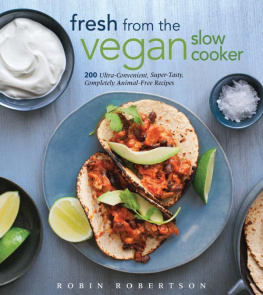
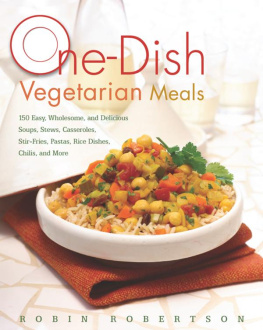
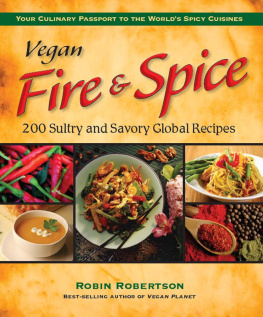
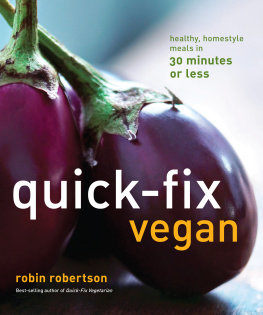
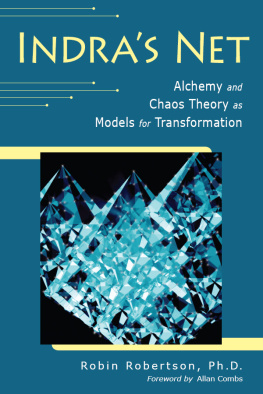
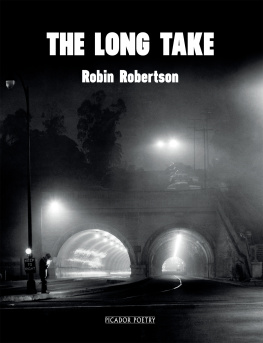
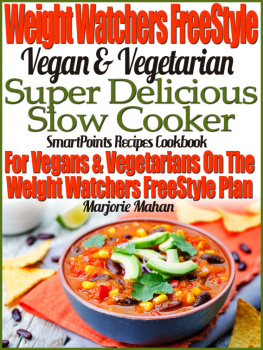

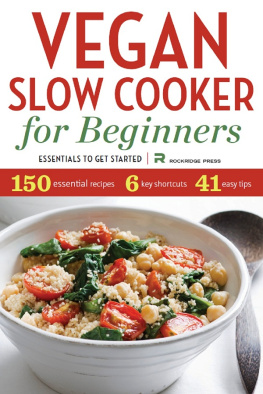
![Moeller - Creative slow-cooker meals: [use two slow cookers for tasty & easy dinners]](/uploads/posts/book/220959/thumbs/moeller-creative-slow-cooker-meals-use-two-slow.jpg)
